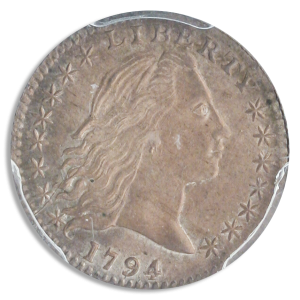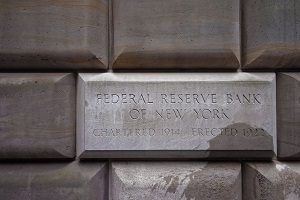The 1794 Flowing Hair Half Dime
Posted on — 2 CommentsThe Flowing Hair Half Dime has the distinction of being one of the first coins issued by the US Mint. Designed by Robert Scot, this silver coin, valued at five cents, was part of the Coinage Act of 1792 which established the United States dollar as the standard unit of money in the country.
The act also created a decimal system for US currency. In this early phase of the US currency system, officials decided to peg the value of the dollar to the Spanish silver dollar. The act authorized the production of coins ranging from Eagles valued at $10 to pieces as small as half cents.
The half dime was designed to be smaller in both diameter and thickness relative to a dime. The first coins were struck in 1792 in a small quantity of 1,500 pieces.
The piece is part of a family of coins that are considered among the rarest in the world. Consider, for example, the Flowing Hair Dollar which was also minted in 1794 and reached a $10 million selling price in 2013. The coin is incredibly rare. Historians have estimated that no more than 130 are likely to still be in existence. Before this sale, the record for the highest amount ever paid for a coin was $4.1 million in 1999. The coin was only produced for two years. The fifteen stars around the perimeter represented the fifteen states that had ratified the constitution. It was the largest coin in use at the time.
The 1794 Flowing Hair half dime, though not as rare, has similar appeal. Many collectors value the coin because it represents the earliest days of the currency system in the US. Coins from this era have associations to some of the most towering figures in our history. In fact, the 1792 Act to Provide For Copper Coinage carries George Washington’s signature making it official law.
Many aspects of the design of the Flowing Hair Half Dime set a precedent and a standard for all the US coins that followed. The image of Liberty became an enduring theme across all following pieces. Liberty, as a design element, remained. However, the way in which it was represented changed over the decades to more accurately reflect the prevailing notion of what “beauty” resembles.
The 1794 Flowing Hair Half Dime, as well as the other coins of the era, also set composition standards. Coins had proportional values of silver to gold that were 15 to 1 respectively. Silver was deemed to be 1485 parts pure silver to 179 parts alloy copper.
Eventually, production of the “Flowing Hair” coin ended and the US mint adopted a new design, the Draped Bust dollar and the circulation of the “Flowing Hair” coins slowly faded from the public.
Collectors seek them today as a reminder of the founding of the nation. The Flowing Hair Half Dime remains one of the earliest records of the imagery used to represent the principles of the country.
Want to read more? Subscribe to the Blanchard Newsletter and get our tales from the vault, our favorite stories from around the world and the latest tangible assets news delivered to your inbox weekly.
Fed Says Rate Hikes Are Coming
Posted onThe Federal Reserve said today it plans to raise its benchmark interest rate at least three times in 2022, in an attempt to tame the big jump in consumer inflation that is spiraling throughout the economy.
The Fed also sped up the pace of its “tapering” or reduced bond-buying spree by $30 billion per month and will end the program in March. The Fed has been buying bonds every month to support the economy after the COVID crisis.
Gold slumped on today’s Fed news, as higher interest rates can be a slight negative factor for physical metals, which are non-interest bearing investments.
Yet, precious metals investors quickly stepped in and bought gold at Wednesday’s low, trimming the weakness seen in both gold and silver.
After trading as low as $1,753.20 an ounce after the Fed meeting, gold has already climbed as high as $1,780.80 as investors used the quick retreat to buy – a $20 plus jump off its intraday low.
Why did gold investors buy the dip? Ultimately, many on Wall Street wonder if the Fed’s action will be too little and too late.
The inflation genie has already been let out of the bottle. In fact, in November, the U.S. consumer price index hit 6.8%–its fastest pace in 39 years.
During inflationary times, investors turn to gold as a vehicle to hedge their assets and protect their purchasing power in times of rapidly rising prices, and that’s what we saw today.
Currently, the official Fed funds rate stands at 0-0.25% which means that three Fed rate hikes would bring the short-term rates as high as 0.75-1.00%. That would still be extremely low interest rates by historical standards. Normal Fed funds rates range in the 3.5-4.5% region, so even a 1.00% Fed funds rate in 2022 would reflect extremely easy and loose Fed monetary policies.
Will those tiny rate increases have any meaningful impact on sizzling hot inflation? Only time will tell.
What we do know is that investors saw value in today’s quick price retreat in gold. There’s still time to buy gold below $1,800 an ounce. Have you considered if you need to increase your allocation to gold? It’s an excellent time to buy.
Want to read more? Subscribe to the Blanchard Newsletter and get our tales from the vault, our favorite stories from around the world and the latest tangible assets news delivered to your inbox weekly.
Gazing into the Crystal Ball: 2022 Outlook
Posted on — 1 CommentAs snow begins to blanket northern parts of our nation and holiday lights twinkle on city streets, Wall Street firms begin rolling out their forecasts, projections and economic outlooks for the next year.
As the nation continues to grapple with political polarization in the wake of the 2020 presidential election, the uncertainty of a new COVID variant, Omicron, and unsettling high levels of consumer inflation, what could lie ahead?
Let’s take a look at a few key themes and forecasts for 2022.
Inflation to Sizzle Next Year
All year long, inflation has been climbing higher. You’ve noticed it at the gas station, the grocery store, at the car dealer and even for everyday goods you buy for your home. You aren’t imagining it. In November, the consumer price index (CPI) surged an alarming 6.8%, recording the biggest jump in 39 years. Don’t expect that to change anytime soon.
In 2022, expect inflation to remain high, says Wells Fargo in its 2022 Annual Outlook. The U.S. is expected to beat all the advanced and developing nations with the highest CPI rate in 2022 with a robust 5.3% inflation rate.
Federal Reserve Interest Rate Hikes Are Coming
After holding interest rates at the 0-0.25% level in an effort to stimulate the economy after the COVID crisis, the Federal Reserve is expected to begin raising interest rates in 2022.
The U.S. Fed has a unique “dual mandate” which are to 1) promote maximum employment and 2) to maintain inflation at the 2% rate over the long run.
Well, inflation is running hog-wild right now and the Fed hasn’t even stepped in to attempt to lasso surging prices in the least.
How is the job front? In November, the U.S. unemployment rate fell to 4.2%, leaving 6.9 million Americans unemployed. These numbers are vastly improved from the depths of the February-April 2020 recession, yet they remain higher than pre-COVID levels at 3.5% and 5.7 million unemployed people in February, 2020.
Inflation will force the Fed into action in 2022. The rising level of consumer prices on everything from lumber for home improvement projects to the price of a new sweater will leave the Fed no choice but to begin raising interest rates next year.
Wells Fargo says the central bank forecasts that the Fed will hike interest rates twice in 2022 by a modest 50 basis points in total. That would still leave the fed funds rate at a historically low level of .50%-.75%.
GDP Growth around the Globe
In 2022, most advanced economies like the U.S., Japan, the Eurozone and the Scandinavian countries will record gross domestic product (GDP) growth in the 3.1 to 4.4% region. Wells Fargo predicts the U.S. will lead the advanced economies with the fastest pace of growth at 4.4% next year. In the developing countries, India is projected to lead with a sizzling 9.2% GDP growth rate in 2022. China is expected to come in at a 5.5% growth rate.
What You Can Do Now
Inflation is running at its highest level in decades, the Fed is poised to hike interest rates and the stock market remains frothy and overvalued.
As you review your financial picture at year-end, consider your portfolio allocations. Are you rebalancing every quarter or at least once a year?
Your current equity allocations are likely stretched and off target leaving you vulnerable to greater market risk, downside action and volatility than you even realize. It’s time to rebalance your portfolio and consider increasing your allocation to tangible assets like physical gold and silver.
Use history as a guide and an example. During the 2008 bear market, the S&P 500 fell 48% in six months. That means if you have $100,000 in stock investments, that value plunged to $52,000. What happened to gold during that time? After the 2008 global financial crisis, gold climbed from $700 to $1,900 an ounce, more than doubling its worth.
Gold acts as an insurance policy, a hedge against equity market declines and a vehicle to protect and grow wealth. As an investor, when you own physical gold, you are building a better diversified portfolio, especially during times of uncertainty that is the world we live in today.
Want to read more? Subscribe to the Blanchard Newsletter and get our tales from the vault, our favorite stories from around the world and the latest tangible assets news delivered to your inbox weekly.
What Happens to a Buffalo with Three Legs?
Posted on — 1 CommentOn the American Plains in 1937, a Buffalo with three legs could easily have been shot by a rancher or eaten for dinner by a pack of wolves.
In the rare coin world, however, a 1937 Nickel with a three-legged Buffalo has become a legendary numismatic prize.
You’ve probably heard of the Indian Head or Buffalo nickel.
Many Americans of a certain age remember these coins surfacing in their pocket change regularly even into the 1970s. Minted from 1913 through 1938, the imposing and memorable coin designed by James Earle Fraser features a handsome Native American on the obverse and a bison on the reverse. It is the believed that “Black Diamond”, a North American bison in New York’s Central Park zoo, served as the inspiration for the coin’s reverse.
In 1937, the Denver Mint produced 17,826,000 of these legendary nickels composed of 75% copper and 25% nickel.
That year, a Denver Mint employee named Mr. Young, took his job quite seriously. He over polished the reverse die with an emery board in an effort to remove clash marks. The result of the excessively polished die variety? The front leg of the Buffalo missing! Hence the Denver Mint created three-legged Buffalo nickels in 1937.
Without a doubt, this is the most famous and highly sought-after key date in the Buffalo nickel series.
Collectors in the late 1930’s quickly discovered the Mint employee’s error and the 1937-D nickel became a classic even in its own time. These important Buffalo nickels were often pulled out of circulation in 1937 and 1938 as collectors eagerly examined their pocket change searching for this renowned coin.
Numismatic experts note that a unique diagnostic feature of the three-legged 1937-D Buffalo is a stream that appears below the bison’s stomach. See a photo of a 1937-D three-legged Buffalo here. Do you see the stream?
Want to read more? Subscribe to the Blanchard Newsletter and get our tales from the vault, our favorite stories from around the world and the latest tangible assets news delivered to your inbox weekly.
Understanding Risk-Adjusted Returns
Posted onIf two separate investments deliver the exact same return over the same period which is better? The concept of risk-adjusted returns helps answer this question.
An investment’s risk-adjusted return reflects the amount of risk an asset presents to deliver a particular return, or possible return. In other words, the risk-adjusted return reflects not only the assets earning power but also the potential for loss.
Here is another way to think about risk-adjusted returns. Consider two hiking trails that both lead to the same destination. One trail is treacherous. It has steep cliffs, jagged rocks, and rushing water. The other trail is flat, and straight. The second path, which presents less risk, is the one with the higher risk-adjusted return because the traveler incurs less risk in their journey to the destination. The first path has a lower risk-adjusted return because the traveler faces more threats on their way to the destination. They may get there but doing so might mean spraining an ankle or breaking a bone.
This measurement is helpful in comparing two investments that may seem identical when examined based only on their historical return.
There are several ways to measure risk adjusted returns. One popular method is to use the Sharpe Ratio which takes the return of the investment less the risk-free rate and divides it by the investment’s standard deviation. The standard deviation could be thought of as more rocks and cliffs on the trail. Typically, a higher Sharpe ratio represents a better investment choice.
The Sharpe ratio illustrates why an investment that delivers 14% in returns might be less desirable than an investment that only delivers a return of 11%. Why? Because the investment that returns 14% can only do so by exposing the investor to greater risk than the risk associated with the investment offering an 11% return.
This concept illustrates how investors can reduce the overall risk profile of their portfolio by including assets with higher risk-adjusted returns. For example, one study showed that allocating 5% to gold can improve the risk-adjusted return in a portfolio consisting of 60% stocks, and 40% bonds.
Now is a good time for investors to revisit the risk-adjusted returns of their portfolio because volatility in the stock market is climbing. Moreover, the median P/E ratio of the S&P 500 over a period of about 150 years is 14.9 and the current P/E ratio is 28.6. This significantly higher figure suggests that investors today have considerably higher expectations for future stock market performance.
Investors can counterbalance this elevated risk by allocating a portion of their portfolio to gold. The reason for this strategy goes beyond today’s heightened P/E ratio. Gold will likely also serve as a volatility stabilizer as the world continues to struggle with a fractured international response to a changing COVID pandemic. Additionally, the Federal Reserve’s recent plans to step back from quantitative easing may also spark a flight from stocks into relatively safer investments.
Risk-adjusted returns reminds us that not all profits are the same even if the percentages are identical. The path journeyed to reach those returns often determines the traveler’s fate.
Want to read more? Subscribe to the Blanchard Newsletter and get our tales from the vault, our favorite stories from around the world and the latest tangible assets news delivered to your inbox weekly.
Dow Drops 600 Points: Uncovering Stock Market Danger
Posted onOn Tuesday, the Dow Jones Industrial average skidded over 600 points intraday. That followed a Black Friday session which saw stocks get hammered as well. What’s going on?
One factor that analysts warned about recently are the historically high levels of margin borrowing.
Indeed, the recent stock plunges reveals the fragility of the uptrend in stocks and underscores how quickly the market can reverse.

If you are unfamiliar with margin buying, it is a strategy that investors can use to buy stocks – using borrowed money. The problem? When stocks fall, those investors often panic and rush to sell or – even worse – get a ‘margin call’ from their brokerage firm requiring them to exit their positions, often at a loss.
Margin borrowings in October were up 42% versus a year ago levels at $935.9 billion, The Wall Street Journal reported on November 28th, using data from the Financial Industry Regulatory Authority, Wall Street’s self-regulator.
That’s a lot of borrowed money driving the recent stock market gains. And, those investors are quick to pull the plug, which can partly explain the pace of the stock market declines on Black Friday and on November 30th.
How does margin buying work? Typically, investors with as little as $2,000 in securities in a brokerage account can use those assets to get a loan, or approval to borrow money and ‘buy on margin.’ If those positions turn against them, the brokerage firm makes a ‘margin call’ requiring them to either put more money into the account or sell the stocks to pay back the loan. That adds to the flurry of selling on days the stock market is down big.
This year’s jump in margin buying is just another warning sign, along with high valuations, that the current stock market euphoria is a delicate house of cards, vulnerable to crumbling quickly.
The Bottom Line
Stock market pullbacks can be scary experiences for investors. What we are seeing now could be the canary in the coal mine. The stock market uptrend is vulnerable. Inflation is rising. The Federal Reserve is warning it may remove monetary accommodation sooner than expected. And, investors have been using borrowed money to play the stock market. If you are concerned, there is a proven strategy to reduce your risk.
For many investors, gold is the answer.
Investors who seek to create a properly diversified portfolio need to include assets that are non-correlated, or those that will rise when others fall. Gold is a non-correlated asset to equities and can help provide effective portfolio diversification. Typically during severe equity downturns, the price of gold has risen often substantially.
During periods of severe stock market stress, gold has traded significantly higher. When the S&P 500 has collapsed by more than 4.4% in a week, or the equivalent of declining by more than two standard deviations, the correlation between stocks and gold drops to -0.15 or -15%, according to the World Gold Council. What this means in plain English is that when stocks fall, gold prices tend to rise. When stocks fall quickly and sharply, gold tends to increase in value even faster as investors turn to the precious metals as a safe haven.
Holding as much as 10% of your portfolio in gold has improved long-run performance returns, according to research from the World Gold Council. It helps investors manage risk and smooth returns, especially during periods of stock market volatility or downturns.
As an investment, gold is considered a safe harbor and offers individuals the opportunity to preserve and grow wealth, especially when other asset classes aren’t performing as well. Gold acts as an insurance policy, a hedge against equity market declines and a vehicle to protect and grow wealth. This paid off for gold investors after the 2008 global financial crisis when gold went from $700 to $1,900.
Do you own enough?
Read More
Examining Stock Market Risk Right Now
Want to read more? Subscribe to the Blanchard Newsletter and get our tales from the vault, our favorite stories from around the world and the latest tangible assets news delivered to your inbox weekly.
Little Known Banking Rules That Could Affect You
Posted on — 1 CommentHow would you feel if your bank denied you access to your money? Or, said you needed to wait 10 days before making a transaction like a wire transfer?
While it may sound like a bad dream, it’s happened to many Americans – including Blanchard clients. If this has in fact already happened to you – don’t despair – you aren’t alone.
There are a surprising number of little known banking rules and regulations that can stand between you and your money – especially if you need it fast.
Even worse, banks are delaying customer’s access to their own money – for 10 days or more.
When you have money in a U.S. bank account, you expect to have access to your money when you need it. Sadly, that’s not always the case.
9 real-life examples our clients told us about what happened when they tried to invest in tangible asset and wire funds:
- “What is this wire for? We need to know or will not send the funds.”
- The bank wasn’t aware of Blanchard and required bank officials to research the company first before releasing the wire transfer.
- “I tried to withdraw a sum over $10,000. The bank told me to come back tomorrow, that I couldn’t take it out that much cash on a moment’s notice.”
- “I wanted to send a $20,000 wire transfer. The main branch of the bank said their internet was down and they couldn’t send it. I went to another bank branch and they said they had to vet Blanchard for 30 days before releasing the wire!”
- “Before agreeing to the send the wire, the bank made me fill out a form detailing where the money was going and why it was going there.”
- “The teller told me no, they won’t approve the wire transfer. I had to fill out documents and talk to a manager first.”
- “My credit union ran a ‘credit check’ on Blanchard before agreeing to transfer the money. I’ve been a customer at this credit union for over 30 years. My wire transfer amount was only $1,500.”
- “The bank manager told me ‘I don’t know where this money is going’ even though I assured them I knew Blanchard well and had done business with Blanchard for years.”
- “My bank held a wire for 5 days before sending funds because they didn’t know who Blanchard was.”
As you may already know, Blanchard was founded in New Orleans in 1975 – and we have been in business for close to 50 years. With five offices across the nation, we’ve served over 600,000 clients.
Seriously. It’s your money. Should you have to jump through hoops to get it or make investments of your choice?
While these banks attempted to cast doubt on your own financial moves, our clients all persevered and eventually were able to gain the access they need and deserve – to their own money!
Some banks are clearly going too far.
A 2020 Financial Times article reported on thousands of complaints by bank customer’s whose accounts were simply frozen. That’s right. Zero access to your cash, with no warning.
“The greater your bank balance and your international connections, the more likely you are to match the profile. The decision to freeze an account often happens with no warning or explanation. Customers suddenly find they have no access to cash; their direct debits and standing orders are suspended,” the Financial Times said.
In one instance, Alex tried to send a bank transfer to his sister last year (and she had the same last name as he did!), yet it wouldn’t go through. The bank told him to call a number to discuss this and was told there had been suspicious activity and his account had been locked.
“My sister shares my surname, yet the bank decided this was so suspicious it immediately locked down all my accounts and turned off my internet banking access,” Alex told the Financial Times.
Are banks overreaching? Probably. Yet, this is a trend. You know better than anyone else what type of investments are right for you and your family. Don’t let anyone at your bank cast doubt on your financial decisions.
If you encounter difficulties of this nature, please know this is more common than you think. Your portfolio manager at Blanchard is always happy to assist where possible.
The surprising regulations, rules and sometimes arbitrary decisions that banks make over access to your money is another reminder about the benefit to holding a portion of your assets in tangible assets like gold and silver bullion and coins:
- Privacy.
- Portability and instant access to your capital.
- Simplified wealth transfer between generations.
Gold, this is just another reason, you can put your trust in precious metals. Take that to the vault!
Want to read more? Subscribe to the Blanchard Newsletter and get our tales from the vault, our favorite stories from around the world and the latest tangible assets news delivered to your inbox weekly.
Examining Stock Market Risk Right Now
Posted onWhile many Americans struggle with the challenges of rising inflation – at the grocery store, at the gas pump, rising rent and more, stock market investors are a complacent bunch right now.

The U.S. stock market is indeed enjoying double-digit gains in 2021, propelled higher by government spending that flooded the economy during the Covid crisis and the Fed’s rock-bottom interest rates.
Can this continue?
There is an old market adage: the stock market takes the stairs up and the elevator down.
That adage reminds us that while stock market gains tend to be slow and steady, stock market crashes tend to be violent, fast and usually quite unexpected.
There are three major risks right now hovering beneath the rosy stock market performance figures this year, which are worth examining. These include: 1) valuation levels 2) margin debt and 3) interest rate shock. Today, we’ll explore valuation levels.
You’ve probably heard that the stock market is “overvalued” by many measures.
Experts like to examine longer-term measures like the Shiller P/E or price-to-earnings ratio, which looks at average earnings over the past 10 years, as a particularly useful metric to determine stock market risk.
Stock market valuations continue to increase. In September, the Shiller CAPE ratio hit 38.34, which marked the fourth month in a row with higher valuations and the highest level since late 2000 (just before the Dot-com bubble burst in 2001).
You may recall, in the late 1990’s, internet stocks skyrocketed – the Dot-com boom, they called it. Many companies had zero earnings, yet speculators drove technology stocks higher and higher betting that someday these Dot-com firms would turn a profit.
The primary cause of the 2001 stock market crash? Overvalued stocks.
It was a painful stock market crash. The NASDAQ stock index lost a stunning 75% of its value from 2000-2002.
That means if you had $100,000 invested in the NASDAQ at the beginning of 2000, your account value fell to $25,000 just two years later.
Then, it took a very long 15 years for the Nasdaq Index to reclaim its 2001 peak. So, that means you would have had to wait 15 years for your account balance to return to the $100,000 level.
How would you feel if your stock portfolio fell even 50% right now and – then took 15 years to get back to break-even?
Let’s shift gears and look at how gold performed during that 15-year period from 2000 to 2015.
Gold climbed 554% from its 2000 low at $276 an ounce to its 2011 high above $1,800 an ounce, before entering a minor correction period and slipping to $1,226 – which registered an overall 344% return for that 15-year period.
The Bottom Line
Stock market crashes can be frightening and even traumatic experiences for investors.
It is another reminder why diversification is so important. Diversification into gold is a proven portfolio diversifier. Holding a position in gold reduces your total account drawdown level during stock market crashes, as gold tends to climb when equities fall. Learn more here.
Check back soon for another analysis of stock market margin debt risks – and why that is worth paying attention to.
Want to read more? Subscribe to the Blanchard Newsletter and get our tales from the vault, our favorite stories from around the world and the latest tangible assets news delivered to your inbox weekly.
What Experts Forecast for The Economy In 2022
Posted onWith less than eight weeks before the end of the year, many are beginning to ask what the US economy might look like in 2022.
The recovery from COVID continues to push forward but the movement is stubbornly slow. Throughout the mid-1990s and mid-2000s the annual U.S. GDP growth surpassed 3 percent. Many analysts believe this performance will be unattainable in the coming years.
There are three reasons for this low growth outlook.
First, long-term unemployment numbers have been persistently low. As a result, economic activity at the consumer level remains muted.

Second, the 2020 recession prevented many businesses from investing in their operations which dramatically slowed innovation. The effect of this interruption will be lasting.
Third, the baby-boom generation continues to enter retirement in massive numbers. This trend accelerated during COVID’s peak when baby-boomers dropped out of the labor force amid lockdowns, layoffs, and plummeting equity markets.
These reasons explain why the U.S. Bureau of Labor Statistics expects 2022 to usher in a period of slow GDP growth that will become the “new normal.” This, however, is just one opinion. What are other analysts forecasting?
Others have similarly low expectations. Goldman Sachs recently reduced their economic growth target for the U.S. to 4.0% for 2022. One reason for this outlook was their expectation of a “longer lasting virus drag on virus-sensitive consumer services.” Goldman also expects consumers to spend less because of the wide scale shift to working from home.
The outlook from U.S. Bureau of Labor Statistics and Goldman Sachs also agrees with forecasts from The Conference Board, a non-profit research organization founded more than 100 years ago. Their analysis, which examines the global GDP, suggests a deceleration as “quarterly growth rates recorded toward the end of next year will likely show a slowing global economy.”
These challenges are likely to be intensified by existing global supply chain challenges which have broken the connection between businesses and consumers.
These projections do not portend doom, but they do paint a very underwhelming picture of the future U.S. and global economy. For investors this likely means that there will be fewer ways to generate a return on their savings. Moreover, those places that do generate an adequate return may present greater risk as the world continues to adjust to a new system. This new system will be characterized by less reliance on global trade, digital disruption, a more geographically distributed workforce, and a decrease in consumer activity.
In this setting, investors should consider defensive moves that diversify their holdings across assets that are not as closely tied to U.S. and global economic growth. Additionally, investors will need to consider assets that can weather inflation. For most investors gold is the answer given that it has delivered an average return of 15% during periods when inflation exceeds 3% according to research from the World Gold Council.
2022 is fast approaching and the time to form a plan is now.
Want to read more? Subscribe to the Blanchard Newsletter and get our tales from the vault, our favorite stories from around the world and the latest tangible assets news delivered to your inbox weekly.
The Intriguing History Behind the 1880 Trade Dollar
Posted on — 3 CommentsWhat currency should be used in world trade? Over 150 years ago, China and the United States wrangled over that very question – just as they do today.
For those of you that don’t follow global economics closely, today, importers and exporters that buy and sell goods across country lines like crude oil, diamonds, cars and vehicle parts and even computers – primarily use the U.S. dollar to complete the transactions. Example: when China wants to buy crude oil from Saudi Arabia – typically those transactions are completed in U.S. dollars. (Although, China is actively exploring alternatives to cut the U.S. dollar out of that picture).
Rewinding history back to the late 1860s and early ’70s, trade between the United States and China was increasing.
Americans were increasingly purchasing and enjoying items like tea and silk from China. However, a threat to this international trade emerged from the unlikeliest of things: the Mexican peso.
It turns out that many Chinese businesses preferred the use the Mexican peso instead of U.S. currency because the peso contained more silver than the standard U.S. dollar. This meant U.S. businesses had to exchange their dollars for pesos every time they wanted to buy tea or silk or other goods from China, which generated high commission fees for U.S. business owners.
The federal government had a solution to this problem: mint a dollar-sized coin known as a “trade dollar” for use in Asian business trade.
To entice the Chinese to use the American Trade Dollar, the U.S. put more silver content into its coin.
The Trade Dollar consisted of 90% silver and weighed slightly more than the peso (420 grains vs. 416). A unique feature of the Trade Dollar is the wording beneath the eagle on the reverse of the coin” “420 GRAINS .900 FINE.” This was included to convince Chinese merchants of its value.
The U.S. minted silver Trade Dollars from 1873 through 1885. During the first two years of production, the United States sent nearly all the minted coins abroad to ease trade problems.
The Trade Dollar was a success in the Orient. Indeed, Chinese businesses took a liking to the coin and preferred its heavier weight over the Mexican peso.
Some Trade Dollars bear Chinese characters called “chop” marks indented on their surface. Experts believe that Chinese merchants punched these chop marks onto the surface of the Trade Dollars as a strategy to test their authenticity. As the Trade Dollar moved from one Chinese merchant to another it would occasionally receive multiple chop marks, adding to the fascinating history of these coins, which were used heavily in international trade.
However, mining activity at home altered the course of history for the Trade Dollar. U.S. mines in the western regions of the country were yielding enormous amounts of silver. This influx of precious metal disrupted the supply and demand dynamics in the market. Silver prices plummeted. As a result, the Trade Dollar fell to an intrinsic value of just 80 cents. Soon after, the U.S. saw large amounts of Trade Dollars flow back into the country where Americans spent the coins at their face value. In response, Congress acted and revoked the coin’s status as legal tender in July of 1876. They continued to mint the coin, but only for the purpose of exportation.
Just two years later, Treasury Secretary John Sherman ended production of the Trade Dollars. However, from 1879 forward, the Treasury issued proof strikes expressly for collectors. Eventually, in early 1887, legislators passed a law allowing those holding U.S. Trade Dollars to redeem their coins. This act brought approximately 8 million U.S. Trade Dollars back into the government’s hands.
Today, the coins are highly sought after by collectors. The 1884 and 1885 trade dollars are considered to be the rarest of these desirable coins.
Are you curious about what this intriguing coin looks like? See an 1880 Trade Dollar here.
Want to read more? Subscribe to the Blanchard Newsletter and get our tales from the vault, our favorite stories from around the world and the latest tangible assets news delivered to your inbox weekly.








